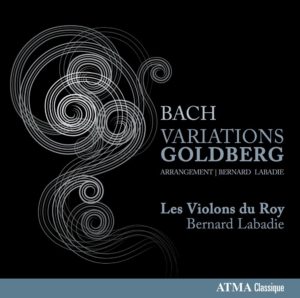You name any instrument or combination thereof and I give you a recording of the Goldberg Variations to match it. Nearly, anyway. The good versions entice the ears or tug the heartstrings; here is a re-release that errs on the right side of success, adding its spin to old Bach’s perennial masterpiece.
It’s the period band Les Violons du Roy performing an arrangement for strings and continuo, concocted and conducted by the orchestra’s founder/director Bernard Labadie. If this sounds familiar, it’s because this recording on Atma Classique was originally released on the Dorian label in 2000. It got a Classicstoday.com 10/10 rating then (see reviews archive) and the re-issue still holds up. With the soloists up front and the continuo back-up band all counted, 24 musicians found employment in this version, upon which the local union must smile benevolently. Other than their function as job creation schemes, the question with such new but not necessarily novel arrangements arises: Why? I skip that question (Labadie smartly answers it in the witty booklet text, in any case) as the real answer is in the listening. And the listening is grand!
While the aria starts sparse, with four instruments, achieving grave, touching clarity, the first and several subsequent variations sound more like a kind of “Brandenburg Variation” or, as Labadie suggests, a what-if version of Charles Avison concerti grossi had only he opted for Bach, not Scarlatti, as the basis for his orchestrations. At their most big-boned, the variations call to mind the times (if not outright sound) when Stokowski still roamed the planet and devoured Bach in massive adaptations—until an asteroid struck, from the crater of which climbed the smaller, more adaptable Brüggen, Harnoncourt, and Hogwood. Variation 22 sounds fully like a Venetian concerto, Variation 23 as if telling of love won and lost, and the hope of regaining it once more. Variation 26 is symphonically jubilant.
And then there is the Quodlibet of course, where Bach takes his established bass line and adds two melodies, both in canon, on top. And not just any melodies, but two very common and popular songs of the time that anyone would have known who heard the Variations then. A bit as if someone today composed a set of the most varied and intricate variations on a sophisticated walking bass and then very casually showed off how he could exactly fit “Beat it” and “Oops, I did it again” on top, while treating them both as fugues. It makes you giggle in awe, and if Bach were not a genius above all suspicion, one might be tempted to think the whole set was retro-engineered from there, just to pull off this stunt.
































